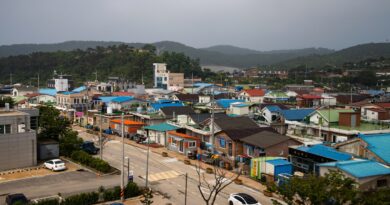Border arrests surged in July, a blow to Biden migration plan
The spike in illegal crossings was most pronounced in the deserts of southern Arizona, despite daytime temperatures that often surpassed 110 degrees. U.S. agents there made about 40,000 arrests in July, the highest one-month total for the Tucson sector in 15 years, CBP data show.
Erin Waters, a spokesperson for CBP, said illegal crossings remain lower than the levels recorded in the months prior to May 11, when the Biden administration ended the pandemic policy known as Title 42. Authorities had used the policy for three years to expel border crossers to Mexico or their home countries.
“Unlawful border crossings have gone down since our border enforcement plan went into effect and remain well below the levels seen while Title 42 was in effect,” Waters said in a statement. “We remain vigilant and expect to see fluctuations, knowing that smugglers continue to use disinformation to prey on vulnerable individuals.”
The Biden administration’s new enforcement plan relies on a blend of incentives and deterrents at the border that allow many more migrants to enter the United States lawfully, with penalties and deportations for those who cross illegally. Biden officials also issued new rules making it easier to deport asylum-seekers if they cross the border illegally or decline to seek protection in another country they pass through en route to the United States.
Republican lawmakers and presidential candidates have continued to criticize Biden over his record at the southern border, where illegal crossings reached all-time highs in 2021 and 2022.
Biden officials say the U.S. border will remain under strain at a time when international migration is at record levels. They expressed guarded optimism after seeing a sharp drop in illegal entries — roughly 70 percent — in the weeks after the new border measures took effect on May 12.
Border apprehensions dropped 42 percent in June, the first full month Biden’s new measures were in effect.
But those gains were nearly erased last month. Large groups of migrants from Mexico, Central America and Africa have been crossing in recent weeks through the deserts west of Nogales, Arizona, to surrender to U.S. agents, straining CBP holding facilities and transportation capacity.
Smuggling organizations have shifted traffic to those areas because they know U.S. authorities have limited detention space and migrants who cross into Arizona are more likely to be quickly released, according to two CBP officials who were not authorized to speak to reporters.
In CBP’s Rio Grande Valley and Del Rio sectors, tens of thousands of migrants crossed the Rio Grande into Texas, skirting concertina wire, floating barriers and other obstacles deployed by Gov. Greg Abbott’s “Operation Lone Star” campaign, the latest figures show.
The proportion of migrants arriving as part of a family group increased last month, creating another challenge for the administration. In 2021 the Biden administration shut down the detention centers for families that used to be run by U.S. Immigration and Customs Enforcement (ICE).
Parents with children comprise about half of the migrants currently held in CBP custody, according to one official who was not authorized to speak to reporters.
To accommodate more families and provided better conditions for children, the Biden administration is expanding its use of temporary “soft-sided” facilities with steep operating costs. The large tent structures provide more amenities than brick-and-mortar Border Patrol stations whose austere holding cells were designed for adults.
During the past week the administration has highlighted its use of deportation flights to return families to Central America, posting videos of parents with children being patted down and boarded onto aircraft.
Border crossings have historically dipped during the hottest months of the summer. But that did not occur in 2021 nor this year, an indication that migration patterns are more attuned to smugglers’ operations and perceived changes in U.S. enforcement, rather than the weather, according to CBP officials.
Department of Homeland Security officials said in July court filings that the administration’s new asylum restrictions had been “remarkably effective” at steering migrants to enter the United States legally – such as by requesting an appointment to seek asylum through the CBP One app. The measures had led to a “swift and sustained decline” in apprehensions, officials told the court.
But U.S. District Judge Jon S. Tigar in California tossed out the asylum rule on July 25, saying the restrictions are unlawful because, among other reasons, federal law says anyone on U.S. soil may request humanitarian protection, no matter how they entered the country. Tigar’s ruling is scheduled to take effect on August 8.
Lawyers for the Biden administration have urged Tigar to stay his own ruling while they appeal it.
Officials have also asked the 9th Circuit Court of Appeals to block Tigar’s decision and indicated that the administration intends to fight the issue to the Supreme Court, if necessary.
Officials said the asylum rules are working and that Tigar’s ruling “threatens to erase that success.”
“The government expects that, if the rule is unavailable for any amount of time, the “current decline in border encounters will quickly be erased by a surge in border crossings that could match—or even exceed—the levels seen in the days leading up to the end of the Title 42” order,” lawyers for the government told the appeals court in a June 27 request for an emergency stay.
Officials asked the appeals court to rule on their request by Thursday.
The Department of Homeland Security, which enforces immigration and border laws, estimated more than 100,000 migrants are in Northern Mexico, within eight hours of the U.S.-Mexico border. “Many more” are transiting to the border, officials said in court filings.
Would-be border-crossers are waiting to see whether the Biden administration’s policies will remain in place, Biden officials said.
Any interruption in those restrictions “will result in another surge in migration that will significantly disrupt and tax DHS operations,” officials said.
U.S. law allows migrants to request asylum once they are inside its borders, but the number of people seeking humanitarian protection has dramatically increased over the years and led to concerns that migrants and smugglers are using the system to get into the United States.
Asylum seekers must have a well-founded fear of being persecuted in their homelands because of their race, religion, nationality, political opinion or another trait. Most asylum seekers do not win their cases, but staggering backlogs in immigration courts have meant that they are likely to remain in the United States for years before a judge renders a decision.
Conservative opponents of the Biden administration have filed separate lawsuits challenging the president’s use of the CBP One app to allow up to 1,450 asylum-seekers and migrants per day to enter lawfully.
Advocates for immigrants are suing to block the administration from routing people through the scheduling app, saying CBP cannot turn back asylum-seekers who don’t have appointments.



